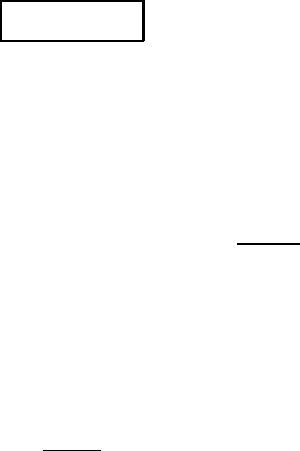Appel W. Mathematics for Physics and Physicists
Подождите немного. Документ загружается.


Random vectors 537
Name m ℓ Name m ℓ
Niobe 8.5 5 Frigga 9.6 6
Feronia 10.3 7 Diana 9.1 5
Klytia 10.3 6 Eurynome 9.3 8
Galatea 10.1 7 Sappho 9.3 6
Eurydike 10.0 8 Terpsichore 9.7 11
Freia 9.0 5 Alkmene 9.4 7
The correlation for the first eight asteroids is r ≈ 0.785, w hich is quite large.
Worse, the correlation for the last five is r ≈ 0.932. Of course, this is merely
an accident, due to the small sample used. There is in fact no correlation
between the length of the name and the magnitude of asteroids. With the
twelve given, the correlation becomes ≈ 0.4 and with fifty asteroids
6
it is only
r ≈ −0.097.
Remark 20.42 The covariance of (X , Y ) may be seen as a kind of “scalar product” of X −E(X )
with Y −E(Y ) and the standard deviation as the associated “norm.” The correlation is then
the cosine of the angle between the two functions in L
2
space:
r =
(X |Y )
kX k
2
kY k
2
.
So there is no surprise in the fact that this number is between −1 and 1. Moreover, |r| = 1 if
and only if the functions X −E(X ) and Y −E(Y ) are linearly dependent, as we found above.
20.6.b Independen t random variables
DEFINITION 20.43 (Independence) Two random variables X and Y are in-
dependent random variables if the joint distribution function can be ex-
pressed as the direct product (or “tensor” product) of their marginal distribu-
tion functions F
X Y
= F
X
⊗ F
Y
, that is, if
F
X Y
(x, y) = F
X
(x) F
Y
( y) for all x, y ∈ R.
It is usual to abbreviate “independent random variables” by i.r.v.
There is an equivalent form of the definition which involves the σ-algebra
generated by a random variable:
DEFINITION 20.44 (σ-algebra generated by an r.v.) Let X be a random vari-
able. The σ-algebra generated by X, denoted T (X ), is the set of all subs ets
of the form X
−1
(A) for a Borel subset A.
PROPOSITION 20.45 Two random variables X and Y are independent if a nd only
if the σ-algebras generated by X and Y are independent, that is, if, for all A ∈ T (X )
and B ∈ T (Y ), we have P(A ∩ B) = P(A) ·P(B).
6
Numbered 51 to 10 0 in the Ephemerids of Minor Planets (Leningrad, 1979).

538 Random variables
If the joint probability density exists, we then have f
X Y
= f
X
⊗ f
Y
, tha t
is,
f
X Y
(x, y) = f
X
(x) f
Y
( y) for all x, y ∈ R.
We have the following important result:
THEOREM 20.46 Two independent r.v. X and Y are uncorrelated.
Proof. We can assume that the variances σ
2
X
and σ
2
Y
exist; otherwise the correlation
is not defined. Then we have
Cov(X , Y ) =
ZZ
(x −m
X
)( y −m
Y
) f
X Y
(x, y) dx dy
=
Z
(x −m
X
) f
X
(x) dx
Z
( y −m
Y
) f
Y
( y) dy = 0,
since each factor vanishes.
The converse is not true in general, however.
Example 20.47 Let Ω = [0, 2π] with the uniform probability measure P = dθ/2π. Let
X (θ) = cos θ and Y = si n θ. The r.v. X and Y are not independent (intuitively, because there
is a relation between them, namely X
2
+ Y
2
= 1), but on the other hand the covariance is
equal to
Cov(X , Y ) =
Z
Ω
cos θ sin θ
dθ
2π
= 0,
so they are uncorrelated.
20.6.c Random vectors
It is now possible to generalize the preceding results to n random variables.
DEFINITION 20.48 An n-dimensional random vector is an n-tuple of ran-
dom variables, or in other words a measurable map
X = (X
1
, . . . , X
n
) : Ω −→ R
n
.
DEFINITION 20.49 The distribution function (or joint distribution func-
tion) of a random vector X is the function defined on R
n
by
F
X
( x) = P
X
i
¶ x
i
for i = 1, . . . , n
, where x = (x
1
, . . . , x
n
).
PROPOSITION 20.50 Let F
X
be the distribution function of X. Then for all
x ∈ R
n
we have
F
X
(−∞, x
2
, . . . , x
n
) = ··· = F
X
(x
1
, . . . , −∞, . . . , x
n
) = ···
= F
X
(x
1
, . . . , −∞) = 0
and F
X Y
(+∞, . . ., +∞) = 1.
Morevoer, F
X
is increasing a nd right-continuous with respect to each variable.

Image measures 539
DEFINITION 20.51 The probability dens ity (or joint probability density) of
a random vector X is the function (or distrib ut ion)
f
X
(x
1
, . . . , x
n
)
def
=
∂
n
∂ x
1
. . .∂ x
n
F
X
(x
1
, . . . , x
n
).
We then have
F
X
(x
1
, . . . , x
n
) =
Z
x
1
−∞
. . .
Z
x
n
−∞
f (s
1
, . . . , s
n
) ds
1
···ds
n
.
20.7
Image measures
20.7.a Case of a single random variable
Exercise 20.5 The probability density of the velocity of an atom of a pe rfect gas is known
(it is a maxwellian
7
). What is the probability density of the kinetic energy mv
2
/2 of this atom?
To treat this kind of problem, we must consider the situation where, given
a random variable X , a second random variable Y = ϕ(X ) is defined. This is
called a change of random variable. The task is to determine the distribution
function of Y , and its probability density, knowing those of X .
When the change of random variable is bijective, there is a unique y = ϕ(x)
associated to any x ∈ R, and it is then easy to see that if f denotes the
probability density of X and g denotes that of Y , then
g( y) =
f (x)
ϕ
′
(x)
x=ϕ
−1
( y)
,
provided ϕ
′
has no zero.
Proof. Indeed, we have G( y) = P{X ¶ ϕ
−1
( y)} = F ◦ϕ
−1
( y) if ϕ is increasing, and
G( y) = P{X ¾ ϕ
−1
(x)} = 1 − P{X < ϕ
−1
( y)} = 1 − F ◦ϕ
−1
( y) if ϕ is decreasing.
Then
g( y) = G
′
( y) =
F ◦ϕ
−1
= ±F
′
◦ϕ
−1
·(ϕ
−1
)
′
= ±
f (x)
ϕ
′
(x)
,
as was to be shown.
If the function ϕ is not a bijection, we have the following more general
result (compare with the change of variable formula for a Dirac distribution,
Exercise 7. 4.d, page 198):
7
In other words, a gaussian with a physicist’s name.

540 Random variables
THEOREM 20.52 Let ϕ : X 7→ Y be a change of random variable and y ∈ R
such that the equation
y = ϕ(x)
has at most cou nta bly many solutions, and let S
y
denote the set of these solutions.
Assume, moreover, that ϕ
′
(x) 6= 0 for x ∈ S
y
. Then the probability density g of Y is
related to the probability density f of X by
g( y) =
X
x∈S
y
f (x)
ϕ
′
(x)
.
20.7.b Case of a random vector
Theorem 20.52 generalizes to a function ϕ : R
n
→ R
n
as follows:
THEOREM 20.53 Let ϕ : X 7→ Y be a change of random vector, and let y ∈ R
n
be such that the equation y = ϕ( x) has at most countably many solutions x
k
, k ∈ I.
Assume, moreover, that the differential dϕ( x
k
) is invertible for all i ∈ I. Then the
probability density g of Y is related to the probability density f ofX by
g( y) =
X
k∈I
f ( x
k
)
|det dϕ(x
k
)|
=
X
k∈I
f ( x
k
)
D(x
1
, . . . , x
n
)
D( y
1
, . . . , y
n
)
,
where the last factor is the inverse of the jacobian matrix of the change of variable.
20.8
Expectation and char acteristic function
20.8.a Expectation of a function of random variables
Let X be a random variable and Y = ϕ(X ). The expectation of Y , if it exists,
can be computed using the probability density f
X
of X by the formula
E(Y ) = E
ϕ(X )
=
Z
Ω
ϕ
X (ω)
dP(ω) =
Z
R
ϕ(x) f
X
(x) dx.
More generally, if Y = ϕ(X
1
, . . . , X
n
) is a random variable defined by
change of variable from a random vector, the expecta tion of Y (if it exists)
may b e computed using the joint probability density f
X
1
···X
n
(x
1
, . . . , x
n
) of
(X
1
, . . . , X
n
) by the formula
E(Y ) =
ZZ
R
n
ϕ(x
1
, . . . , x
n
) f
X
1
···X
n
(x
1
, . . . , x
n
) dx
1
. . .dx
n
.

Expectation and characteristic function 541
For instance, if X and Y are random variables , the expectation E(X Y ) of
the product X Y can be computed using the joint probability density f
X Y
:
E{X Y } =
Z
Ω
X (ω) Y (ω) dP(ω) =
ZZ
R
2
x y f
X Y
(x, y) dx dy.
THEOREM 20.54 The expectation has the following properties:
i) it is linear, that is, we have
E
n
P
i
λ
i
X
i
o
=
P
i
λ
i
E{X
i
}
whenever the right-hand side is defined;
ii) if X is a lmost surely equal to a constant a, E{X } = a; in particular, we have
E
E{X }
= E{X };
iii) we have
E{X Y }
2
¶ E{X
2
}E{Y
2
},
by the Cauchy-Schwarz inequality, with equality if and only if X and Y are
linearly dependent;
iv) if X and Y are independent, then E{X Y } = E{X }E{Y }.
20.8.b Moments, variance
Using the formulae of the previous section, we see t hat the moments and cen-
tered moments of a random variable X are given by expectations of functions
of X , namely,
ˆµ
k
= E{X
k
} and µ
k
= E
n
X −E{X }
k
o
.
Moreover, the k-th moment (centered or not) exists if and only if the function
x 7→ x
k
f (x) is Lebes gue-integrable, where f is the probability density of X ,
that is, if
Z
x
k
f (x) dx < +∞.
As a special case, the variance is given by
σ
2
= E
(X −E{X })
2
} = E{X
2
}−E{X }
2
.
20.8.c C haracteristic function
DEFINITION 20.55 The characteristic function ϕ
X
of a random variable X
is the function defined for ν ∈ R by
ϕ
X
(ν) = E
e
iνX
.

542 Ran dom variables
The following result is then immediate.
THEOREM 20.56 The characteristic function ϕ
X
of a random variable X is the
Fourier transform
8
of its probability density (in the sense of distributions):
ϕ
X
(ν) =
Z
Ω
e
iνX (ω)
dP(ω) =
Z
∞
−∞
e
iνx
f (x) dx.
Notice that this quantity is always defi ned, for any random variable X , because
|e
iνX
| = 1 and Ω is of total measure equal to 1 (or equivalently, because the
density probability f , when it exists as a function, is Leb esgue-integrable).
According to the general theory of the Fourier transform, we have there-
fore:
PROPOSITION 20.57 Let X be a random variable and let ϕ
X
be its characteristic
function. Then
i) ϕ
X
(0) = 1 and
ϕ
X
(ν)
¶ 1 for a ll ν ∈ R;
ii) if the k-th order moment of X exists, ϕ
X
can be differentiated k times and we
have
µ
k
= E{X
k
} = (−i)
k
ϕ
(k)
X
(0);
iii) since X is real-valued, ϕ
X
is hermitian, i.e., we have ϕ
X
(−ν) = ϕ
X
(ν).
Proof. Note that ϕ
X
(0) =
R
+∞
−∞
f
X
(x) dx = 1 or, to phrase it differently, we have
ϕ
X
(0) = E{1} = 1. The last two properties are direct translations of known results of
Fourier transforms.
THEOREM 20.58 The characteristic function of a random variable X determines
uniquely the distribution function of X .
In other words, two random variables have the same character istic function if
and only if they have the sa me distrib ut ion function. (This theorem follows
from an inversion formula which is the analogue of the Fourier inversion
formula and is due to P. Lévy).
Before going to the next section, note also the following important fact:
PROPOSITION 20.59 The characteristic function of the sum of two independent
random variables is the product of the characteristic functions of the summands:
ϕ
X +Y
(ν) = ϕ
X
(ν) ·ϕ
Y
(ν).
8
Be careful with the various conventions for the Fourier transform! It is usual in probability
to omit the factor 2 π which often oc curs in analysis.

Sum and product of random variables 543
Proof. Let f
X Y
be the joint probability density of (X , Y ). Since X and Y are
independent, we have f
X Y
(x, y) = f
X
(x) f
Y
( y) and hence
ϕ
X +Y
(ν) = E
e
iν(X +Y )
=
ZZ
e
iν(x+ y)
f
X Y
(x, y) dx dy
=
Z
e
iν x
f
X
(x) dx
Z
e
iν y
f
Y
( y) dy = ϕ
X
(ν) ·ϕ
Y
(ν)
by the expect ation formula for a change of random variables.
20.8.d Ge nerating function
DEFINITION 20.60 The generating function G
X
of a random var iable X is
the function of a real variable s defined a s the expectation of s
X
:
G
X
(s) = E(s
X
)
when it ex ists.
THEOREM 20.61 Let X : Ω → N be an integer-valued discrete r.v., and let p
n
=
P(X = n) for n ∈ N. Then G
X
is defined at least for s ∈ [−1, 1] and is of C
∞
class
on ]−1, 1[. Moreover, we have G
X
(1) = 1 and
G
X
(s)
¶ 1 for a ll s ∈ [−1, 1].
In addition, for s ∈ [−1, 1], we h ave the series expansion
G
X
(s) =
∞
P
n=0
p
n
s
n
and hence P(X = n) =
G
(n)
X
(0)
n!
.
In particular
E(X ) = G
′
X
(1) and Var(X ) = G
′′
X
(1) + G
′
X
(1) −
G
′
X
(1)
2
.
20.9
Sum and product of random variables
20.9.a Sum of random variables
Let us assume that every day I eat an amount of chocolate which is between
0 and 100 g, and let us model this situation by a random variable X
1
for the
amount eaten on the first day, another random variable X
2
for th e amount
eaten on the second day, and so on, each random variable being assumed
to have a uniform distribution on [0, 100]. We would like to known the
distribution of the total amount of chocolate eaten in two days.
544 Ran dom variables
Let us start with a slightly simplistic reasoning, where the amount of
chocolate can only take integral values k between 1 and 100 with probabil-
ity P(X
i
= k) = 1/100. There is a very small probability that I will eat only
2 g of chocolate, since this requires that I eat 1 g the first day and 1 g the sec-
ond, with a total probability equal to 1/10 000 (if we assume that the amount
eaten the first day is independent of the amount eaten the second). The prob-
ability that I ea t 5 g is larger, since this may happen if I ea t 1 g and then 4 g,
or 2 g and then 3 g, or 3 g and then 2 g, or (finally) 4 g a nd then 1 g; th is gives
a total probability equal to 4/10 000.
The reader will now have no trouble showing that the probability that I
eat n grams of chocolate is given by the formula
P(X
1
+ X
2
= n) = P(X
1
= 1) P(X
2
= n − 1)
+ P(X
1
= 2) P(X
2
= n − 2) + ···+ P(X
1
= n −1) P(X
2
= 1).
With a finer subdivision of the interval [0, 100], a similar formula would hold,
and pas sing to the continuous limit, we expect to find that
f
total
(x) =
Z
100
0
f (t) f (x − t) dt = f ∗ f (x),
where f
total
is the density of X
1
+ X
2
and f that of X
1
or X
2
(since the support
of f is [0, 100]). In other words, the probability dens ity of the sum of two
independent random variables is the convolution product of the probability
densities of the arguments.
This result can be established rigorously in two different manners, using a
change of variable or the characteristic function. The reader may find either
of those two proofs more enlightening than th e other.
(Using the characteristic function)
From Proposition 20.59 we know that the characteristic function of the sum of
two independent random variab les is the product of the characteristic functions
of the summands. Using the inverse Fourier transform, we obtain:
THEOREM 20.62 (Sum of r.v.) Let X
1
and X
2
be tw o independent random var i-
ables, with probability densities f
1
and f
2
, respectively (in the sense of distributions).
Then the probability density of the sum X
1
+ X
2
is given by
f
X
1
+X
2
= f
1
∗ f
2
,
or equivalently
f
X
1
+X
2
(x) =
Z
+∞
−∞
f
1
(t) f
2
(x − t) dt,
which is only correct if the random variables involved are continuous, the probability
densities then being integrable functions.

Sum and product of random variables 545
If we denote by
ˇ
f
2
the transpose of f
2
, then the probability density of the difference
X
1
− X
2
is given by
f
X
1
−X
2
= f
1
∗
ˇ
f
2
or f
X
1
−X
2
(x) =
Z
+∞
−∞
f
1
(t) f
2
(x + t) dt.
Note that
R
f
X
1
+X
2
=
R
f
X
1
·
R
f
X
2
= 1, as it should be.
(With change of variables)
Let now f
2
(x
1
, x
2
) d enote the joint probability density of t he pair of random
variables (X
1
, X
2
), and make the ch ange of variab les Y
1
= X
1
and Y
2
=
X
1
+ X
2
. The jacobian of this transformation is given by
| J | =
D( y
1
, y
2
)
D(x
1
, x
2
)
=
1 0
1 1
= 1,
and the joint probability density of (Y
1
, Y
2
) is g( y
1
, y
2
) = f
2
( y
1
, y
2
− y
1
); the
probability density of Y = X
1
+ X
2
= Y
2
is the marginal density, so we get:
THEOREM 20.63 (Sum of r.v.) Let Y = X
1
+ X
2
and let f
2
(x
1
, x
2
) denote the
joint probability density of the pa ir (X
1
, X
2
). Then the probability density of Y is
given by
g( y) =
Z
+∞
−∞
f
2
(t, y − t) dt.
If the random variables X
1
and X
2
are independent, we have f
2
= f
X
1
⊗ f
X
2
and the
probability density of Y is the convolution g = f
X
1
∗ f
X
2
:
g( y) =
Z
+∞
−∞
f
X
1
(t) f
X
2
( y − t) dt.
Example 20.64 The sum of two independent gaussian random variables X
1
and X
2
, with means
m
1
and m
2
and variance σ
2
1
and σ
2
2
, respectively is another gaussian variable.
Adpating the result of Exercise 10.2 on page 295, which computes the convolution of two
centered g au ssians, one can show that X
1
+ X
2
is gau ssian with mean m
1
+ m
2
and variance
σ
2
1
+ σ
2
2
.
The following result is also very useful:
THEOREM 20.65 (Bienaym
´
e identity) Let X
1
, . . . , X
n
be independent random
variables, each of which has finite variance Var(X
i
) = σ
2
i
. Then the variance of the
sum e xists and is the sum of the variances of the X
i
: we have
Var(X
1
+ ···+ X
n
) = Var(X
1
) + ···+ Var(X
n
).
Proof. Without loss of generality, we may assume that each random variable is cen-
tered (otherwise, replace X
i
by X
i
−E(X
i
) without changing its variance).

546 Random variables
Let ϕ
i
denote the characteristic function of the random variable X
i
. We have
ϕ
′
k
(0) = 0 for k = 1, . . . ,n, and by Theorem 20.59 on page 542 we c an write
ϕ
X
1
+···+X
n
(ν) = ϕ
1
(ν) ·ϕ
2
(ν) ···ϕ
n
(ν).
On the other hand, the variance of X
k
is given by Var(X
k
) = −ϕ
′′
k
(0). It th erefore suf-
fices to differentiate the above function twice and the n evaluate the resulting expression
at 0. Since the reader will easily check that all first derivatives give zero contributions,
there only remains the formula
ϕ
′′
X
1
+···+X
n
(0) = ϕ
′′
1
(0) ·ϕ
2
(0) ···ϕ
n
(0) + ···+ ϕ
1
(0) ···ϕ
n−1
(0) ·ϕ
′′
n
(0).
Since in addition we have ϕ
k
(0) = 1 for all k, the proof is complete.
20.9.b Pr oduct of random variables
While we are on this topic, we might as well consider the topic of product
of random variables. For this, put Y
1
= X
1
and Y
2
= X
1
X
2
. This change of
variable has jacobian
| J | =
D( y
1
, y
2
)
D(x
1
, x
2
)
=
1 0
x
2
x
1
= |x
1
|,
and h ence we ob tain:
PROPOSITION 20.66 (Product of r.v.) The probability density of Y = X
1
X
2
is
given by
g( y) =
Z
+∞
−∞
f
2
t,
y
t
1
|t|
dt,
in terms of the joint probability density f
2
of (X
1
, X
2
). If the random variables X
1
and X
2
are independent, w e have
g( y) =
Z
+∞
−∞
f
X
1
(t) f
X
2
y
t
1
|t|
dt.
Similarly, the reader will have no difficulty ch ecking t he following:
PROPOSITION 20.67 (Ratio of r.v.) Th e probability density of Y = X
1
/X
2
is
g( y) =
Z
+∞
−∞
f
2
(t, t y) |t| dt
and, if the random variables X
1
and X
2
are independent,
g( y) =
Z
+∞
−∞
f
X
1
(t) f
X
2
(t y) |t| dt.
